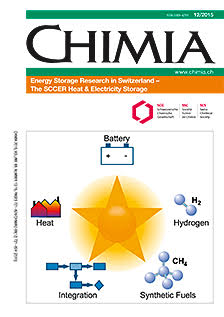Electrochemical CO₂ Reduction – A Critical View on Fundamentals, Materials and Applications
DOI:
https://doi.org/10.2533/chimia.2015.769Keywords:
Co2 reduction reaction, Electrolyzer, Energy conversion, Gas diffusion electrode, Power-to-gas/liquidAbstract
The electrochemical reduction of CO2 has been extensively studied over the past decades. Nevertheless, this topic has been tackled so far only by using a very fundamental approach and mostly by trying to improve kinetics and selectivities toward specific products in half-cell configurations and liquid-based electrolytes. The main drawback of this approach is that, due to the low solubility of CO2 in water, the maximum CO2 reduction current which could be drawn falls in the range of 0.01–0.02 A cm–2. This is at least an order of magnitude lower current density than the requirement to make CO2-electrolysis a technically and economically feasible option for transformation of CO2 into chemical feedstock or fuel thereby closing the CO2 cycle. This work attempts to give a short overview on the status of electrochemical CO2 reduction with respect to challenges at the electrolysis cell as well as at the catalyst level. We will critically discuss possible pathways to increase both operating current density and conversion efficiency in order to close the gap with established energy conversion technologies.
Downloads
Published
Issue
Section
License
Copyright (c) 2015 Swiss Chemical Society

This work is licensed under a Creative Commons Attribution-NonCommercial 4.0 International License.







